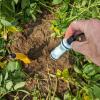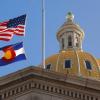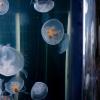Faculty
 PhD student Laura Shannon, alongside Professors Greg Rieker and Peter Hamlington of the Paul M. Rady Department of Mechanical Engineering are setting fires inside wind tunnels to gain a better understanding of how fire spreads across different terrain. The team says their findings could help keep communities safer in a world where climate-driven wildfire is becoming more common—and more dangerous.
PhD student Laura Shannon, alongside Professors Greg Rieker and Peter Hamlington of the Paul M. Rady Department of Mechanical Engineering are setting fires inside wind tunnels to gain a better understanding of how fire spreads across different terrain. The team says their findings could help keep communities safer in a world where climate-driven wildfire is becoming more common—and more dangerous. Faculty member Carmen Pacheco is the architect behind the Food Engineering Graduate Certificate, one of CU Boulder's most innovative academic ventures. Launched in 2024, the program was designed to introduce engineering students to the science behind their favorite foods and career opportunities in the food industry, but it can also reinforce scientific concepts that students can apply to any engineering discipline.
Faculty member Carmen Pacheco is the architect behind the Food Engineering Graduate Certificate, one of CU Boulder's most innovative academic ventures. Launched in 2024, the program was designed to introduce engineering students to the science behind their favorite foods and career opportunities in the food industry, but it can also reinforce scientific concepts that students can apply to any engineering discipline. Soil is comprised of an intricate network of bacteria and other microbes that humans depend on, but this complex environmental system is constantly shifting, making it difficult for scientists to measure. Associate Professor Gregory Whiting and his team of researchers are developing reliable, inexpensive and easy-to-deploy sensors that monitor soil in real time to help farmers optimize their use of fertilizers, reduce greenhouse gas emissions and save money in the process.
Soil is comprised of an intricate network of bacteria and other microbes that humans depend on, but this complex environmental system is constantly shifting, making it difficult for scientists to measure. Associate Professor Gregory Whiting and his team of researchers are developing reliable, inexpensive and easy-to-deploy sensors that monitor soil in real time to help farmers optimize their use of fertilizers, reduce greenhouse gas emissions and save money in the process. Assistant Teaching Professor James Harper recently led a behavioral study analyzing toilet use in Cambodia. Their goal was to introduce a new, smart toilet design that can keep rural households safe and protect the environment. But while households reported that they liked the new system, a crucial piece was missing: using it correctly.
Assistant Teaching Professor James Harper recently led a behavioral study analyzing toilet use in Cambodia. Their goal was to introduce a new, smart toilet design that can keep rural households safe and protect the environment. But while households reported that they liked the new system, a crucial piece was missing: using it correctly. Research Professor Jacob Segil collaborated with Dr. Omer Mei Dan from the University of Colorado Anschutz School of Medicine to create a redesigned surgical instrument called the CAP-LIFT cannula. The device was recently launched in October, and within the first few weeks used in over 100 successful surgeries.
Research Professor Jacob Segil collaborated with Dr. Omer Mei Dan from the University of Colorado Anschutz School of Medicine to create a redesigned surgical instrument called the CAP-LIFT cannula. The device was recently launched in October, and within the first few weeks used in over 100 successful surgeries. University of Colorado Boulder researchers have been shaping space exploration for decades and now are expanding into space law. As more nations launch satellites, space probes, and military hardware into orbit, policy has become an
University of Colorado Boulder researchers have been shaping space exploration for decades and now are expanding into space law. As more nations launch satellites, space probes, and military hardware into orbit, policy has become an Assistant Professor Nicole Xu has been selected as a recipient of the 2025 Packard Fellowships for Science and Engineering. The award provides some of the nation’s most promising early career scientists and engineers flexible funding to test novel ideas and lead research that drives real-world impact.
Assistant Professor Nicole Xu has been selected as a recipient of the 2025 Packard Fellowships for Science and Engineering. The award provides some of the nation’s most promising early career scientists and engineers flexible funding to test novel ideas and lead research that drives real-world impact. Hanspeter Schaub has been officially inducted into the National Academy of Engineering.A distinguished professor and chair of the Ann and H.J. Smead Department of Aerospace Engineering Sciences at the University of Colorado Boulder, Schaub was
Hanspeter Schaub has been officially inducted into the National Academy of Engineering.A distinguished professor and chair of the Ann and H.J. Smead Department of Aerospace Engineering Sciences at the University of Colorado Boulder, Schaub was Scott Diddams was elected to the National Academy of Engineering Class of 2025 for his outstanding contributions in optical frequency combs and their applications.
Scott Diddams was elected to the National Academy of Engineering Class of 2025 for his outstanding contributions in optical frequency combs and their applications. Assistant Professor Robert MacCurdy and fourth-year PhD student Charles Wade have created an open-source design system software package that uses functions and code to map not just shapes, but where different materials belong in a 3D object. The project, called OpenVCAD, has the potential to transform 3D printing by enabling engineers to design multi-material objects smarter and more efficiently.
Assistant Professor Robert MacCurdy and fourth-year PhD student Charles Wade have created an open-source design system software package that uses functions and code to map not just shapes, but where different materials belong in a 3D object. The project, called OpenVCAD, has the potential to transform 3D printing by enabling engineers to design multi-material objects smarter and more efficiently.

